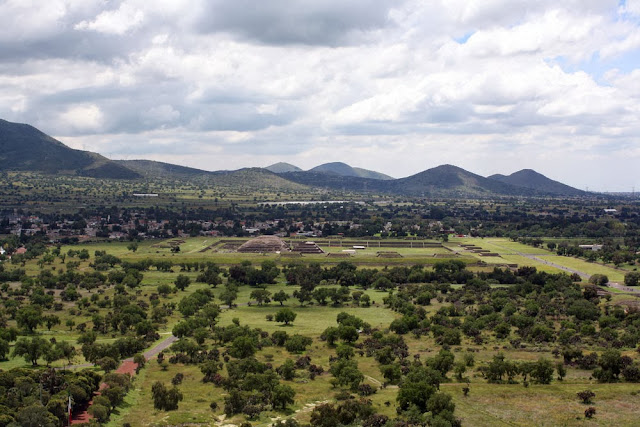
Start from the beginning of our Mexico trip.
One of the biggest draws of visiting central Mexico is the chance to see the ancient ruins left behind by the pre-Hispanic civilizations. We visited three different sites, built by three different cultures: Monte Alban from the Zapotecs, Teotihuacán from a mysterious disappeared culture, and Tenochtitlán from the Aztecs.
Monte Alban
Contemporaries of the ancient Greeks and Romans, the Zapotecs inhabited the mountaintop ceremonial center of Monte Alban for more than a thousand years, from 500 B.C.E. to 800 C.E. Archeological finds from the early stages of construction suggest that it might have been the first culture in Mexico with a written language and calendar. The city reached its peak from about 300 to 700 C.E., when it controlled at least 200 other settlements in the surrounding valleys. Most of the existing ruins date from this period, and the architectural style — including sloping staircases, corniced walls and ball courts — suggests influences from the civilization of Teotihuacán in the Valley of Mexico. For unknown reasons — possible theories include drought, disease or revolt — the city subsequently declined and was completely abandoned by 1000 C.E. [1]
A 30-minute bus ride from Oaxaca, the ruins were nearly deserted when we visited. We enjoyed wandering around the site, which is amazingly well-preserved and which boasts beautiful scenery even without the ruins. It was our favorite site of the three we saw, even though its buildings don't approach the scale of those at Teotihuacán.
 |
| Excavations at Monte Alban have revealed ceremonial altars, pyramids, palaces and more than 170 tombs. |

Scroll to the right to see a panorama of the Monte Alban site.
Teotihuacán
At the same time that the Zapotecs were ruling the Oaxacan valleys, the Teotihuacanes controlled the Valley of Mexico, near present-day Mexico City. At its height in 500 C.E. the city housed at least 200,000 inhabitants and covered more than 12 square miles. But the city was abandoned by 700 C.E. and little is known about the people who built it — their language, where they came from and why they left remain a mystery. Scholars believe the decline was gradual, caused by overpopulation and the depletion of natural resources. The name Teotihuacán means "place where gods were born," and for centuries the city remained a pilgrimage for Aztec royalty, who believed that the gods created the universe there. [2]
It's one of the most popular day trips from Mexico City and our guidebook had warned that armed robberies of the bus were not uncommon. At the bus station, they videotaped everyone on board, which turned out to be an amusing precaution because additional passengers were allowed to board throughout the trip without being videotaped. All the potential robbers had to do was get on at the second stop. Luckily, no one targeted our bus (our book was several years out of date and Mexico has gotten safer in the past few years).
For the first time it didn't rain, and it was even sunny, making it easily the best day of our trip to this point (after our first few mediocre days in Mexico City). The site is roughly 2 kilometers long and as with most archeological sites in Mexico, you are free to walk all over the ruins. One of the most surprising things about traveling outside of the U.S. for me has always been how much laxer the rules are, both in terms of historical preservation and visitor safety. Annoyingly, the Mexican government allows hawkers onto the site and they're unfailingly persistent, following you around selling masks, instruments and other trinkets even after you've indicated you're not interested.
 |
| Standing atop the Pirámide del Sol, looking toward La Ciudadela, a sunken complex thought to have been the residence of the city's ruler. |
 |
| Us on top of the Pirámide del Sol. |
Tenochtitlán
Present-day Mexico City sits on the ruins of the Aztec civilization of Tenochtitlán, a metropolis of great wealth, extensive trade and towering pyramids. According to legend, the wandering Aztec tribe reached a small swampy island in 1325, where they witnessed an eagle standing atop a cactus and devouring a snake, which they interpreted as the fulfillment of an ancient prophecy and a sign to stop and build a great city. Despite the challenges of building a city on a lake, they persisted, and by the time of the Spanish conquest in 1521, Tenochtitlán housed up to 200,000 people, connected by canals and causeways and supplied with fresh water by two aqueducts. It was four times the size of the contemporary London and far larger than any Spanish city. [3]
At the heart of the city stood the Pyramid of Huitzilopochtli, also called the Templo Mayor. The temple was enlarged several times, with each new stage of construction accompanied by the sacrifice of captured warriors. As with many of Mexico's pre-Hispanic cultures, death and sacrifice played an important role in Aztec mythology. Not only did the Aztecs extract vast resources from conquered tribes, including jade, cotton, tobacco and cacao, but they also regularly waged war to assure a steady supply of sacrificial victims for the god Huitzilopochtli. The Spanish found the Templo Mayor gloomy and grotesque and thought human sacrifice was barbaric, which seems ironic given the ongoing Spanish Inquisition and the torture inflicted by the hands of the church.
- Steph
Sources:
[1] Frommer's Oaxaca City; Moon Oaxaca; Lonely Planet Monte Alban
[2] Lonely Planet Teotihuacan; Frommer's Mexico City
[3] Frommer's Mexico City; Lonely Planet Mexico City; Metropolitan Museum of Art
Keep reading: The city of Oaxaca









No comments:
Post a Comment
All comments are moderated before publishing. Comments with links (unless directly relevant to the post) will not be approved. No spam, please.